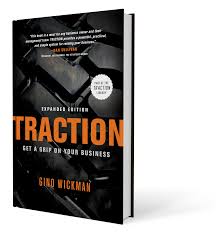
How many times have you said or heard that phrase?
Dumb question, because in 2019 this refrain is so commonplace.
Productivity despair is a reality in the digital age.
Between smartphones, social media, desktop notifications, texts, emails and heck, even air raid sirens, the distractions to daily life are more than has ever been experienced in the history of the world. No one will blame you for feeling like this.
The job of a business leader is to create an organization of employees facing the same challenges and to assist them to move forward. Like a car on a sheet of ice spinning its wheels at 90 mph but only moving at 2 mph, many of the activities of employees are merely keeping people busy, not moving the company forward.
The impact of all this spinning is burnout and despair. People lack purpose because they don’t see results. Results keep employees, owners, and clients happy and boost morale. Morale is an intangible asset that will assist you to create a “sticky” culture.
Traction Book Review
Gino Wickman has written a prescriptive book for this problem. Aptly named “Traction”, it is an operating system to be followed. As someone who has consulted with many businesses, he designed his system and has implemented it for hundreds of companies to address these exact challenges.
This is not another business book, it’s an operating system.
Wickman coins the phrase Entrepreneurial Operating System (EOS) for what he has designed in his book. Unlike most business books about ideas, Traction is a book about action. He outlines meeting agendas for the weekly, monthly, quarterly and annual meetings. There are templates for setting quarterly goals and meeting agendas for reinforcing those goals. Nothing about this book is left to the whims of a leader. Everything is structured in quarterly goals.
People don’t have enough structure.
That lack of structure leads to a busy culture of managing fires rather than managing what moves the organization forward. I believe Wickman’s diagnosis is correct and the solution to a busy-ness culture in an organization is to create more structure. Only with the proper procedures in place will people be able to focus. The focus creates traction.
Traction assists the reader to identify core processes for their business and to document those. Once documented, the processes are bound and labeled as “The Company Way”. This mental shifting of a way in which a company operates communicates to employees that the business maintains a structure independent of personalities.
This structure also moves a company away from a superstar culture where certain people are above the law. Creating and maintaining structure promotes accountability. As much as you may bristle at that word, Wickman argues holding managers accountable to their goals on a weekly basis directly leads to the traction.
Traction is prescriptive and dogmatic and would benefit your company.
I freely admit the distractions of the everyday quell my personal productivity. I also see this daily in the lives of my clients.
Chasing the tail for daily crises at the expense of long term value has dovetailed nicely with understanding my hourly value. Structuring your week, month and annual quarters of your life identifies those activities that create the value. Similar to planning a vacation, these goals should structure the future and create stability for your organization.
I highly recommend this book to those who are prepared for it.
It won’t make you feel good.
It may make you feel like you’ve been managing your company all wrong for years. I believe, however, that if you are willing to spend the hours, weeks and months to implement this system, you will likely feel like you’re moving your organization forward, and that’s where the rubber meets the road.
